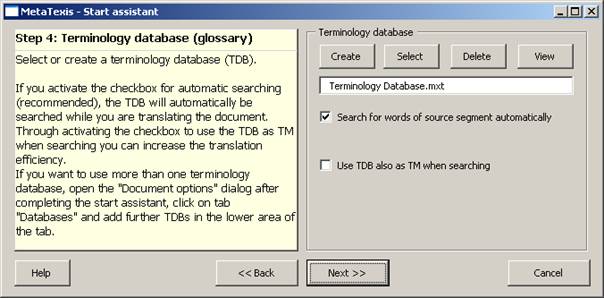
In Step 4 you can decide whether and how you want to use a terminology database (TDB).

A terminology database (or glossary, as it is sometimes called) can be very helpful when you translate text with special terminology or when you translate documents of the same kind very often. If this is the case, you can easily forget about how you have translated some expressions. Moreover, the customer often requires you to use a special terminology. In these cases it is useful to use a terminology database.
When you run the Start Assistant for the first time, the default TDB is assigned ("Terminology Database.mxt"), located in the MetaTexis program directory. Thereafter, the last setting made in the Start Assistant is reproduced (except if you have loaded standard settings or imported settings from another document in step 1).
You have the following options:
· If you leave the TDB text box empty, all other settings will be ignored, and you will not be able to use MetaTexis TDB functions. Usually you will use a TDB to increase your translation efficiency and to ensure consistency of your translations.
· To create a new TDB, click the Create button (for more information, see the Local MetaTexis Databases chapter). To select an existing TDB, click the Select button. To un-assign a TDB, click the Clear button. To view the selected TDB, click the View button.
· If you activate Search for words in source segment automatically, when a TU is opened MetaTexis will automatically look for the words present in the source segments of the specified TDB (only if there is no translation) and will present you with the terminology found (if any).
Note: If you do not activate the automation options, you can still use the TDB functions manually.
· When the Use TDB also as TM when searching checkbox is active, the TDB will also be searched as TM, that is, the terminology entries in the TDB will be treated as TUs. This can further increase your translation efficiency, for example, when the text to be translated contains parts which do not consist of sentences but terminology listings.